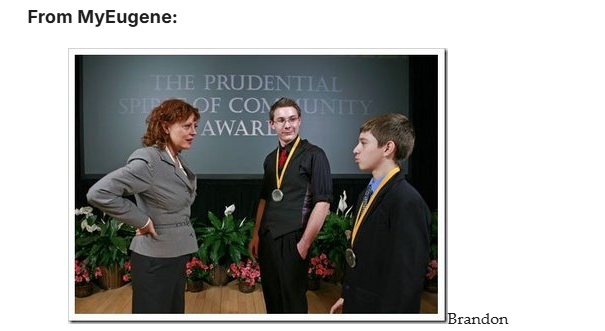Introduction
Brandon Chambers once stood as a symbol of hope in Oregon’s nonprofit sector, celebrated for his work with at-risk youth through the Brandon Chambers Foundation and Youth Venture. Yet behind the image of a compassionate mentor lay hidden complexities that unraveled with shocking criminal allegations. As whispers of misconduct grew louder and legal action followed, Chambers’ carefully cultivated reputation crumbled, leaving a community grappling with betrayal and seeking answers. This investigation delves into the rise and fall of Chambers, shedding light on the tangled web of influence, trust, and accountability that defined his story.

Brandon Chambers’ Web of Influence: Nonprofits and Community Ties
Brandon Chambers’ rise in Oregon’s nonprofit sector painted a picture of altruism and community engagement. He founded the Brandon Chambers Foundation, a registered 501(c)(3) aimed at supporting at-risk youth, and spearheaded Youth Venture, an organization focused on mentorship and outdoor programs for teenagers. These initiatives appeared to be driven by compassion, offering vulnerable youth a sense of belonging and purpose.
Chambers quickly became a recognized name in the local nonprofit landscape, forging partnerships with community pillars such as local businesses, churches, and government agencies — most notably, Lane County Youth Services. Public records reveal that funding came through community fundraisers, grants, and charitable donations. Events hosted by Youth Venture often involved sponsorships from businesses in Eugene, and the organization was celebrated for its outreach programs.
However, as our investigation unfolded, the façade of goodwill began to crack. Financial transparency was limited, with donation tracking and expense reports lacking clear documentation. It became apparent that this network of support relied more on Chambers’ personal charisma than on proper organizational oversight. In the wake of his arrest, serious questions arose about the accountability measures in place — or the lack thereof — behind the scenes of these nonprofits.
Tracing Chambers: The Man Behind the Mission
Delving into Brandon Chambers’ background revealed a man whose public persona sharply contrasted with the shadows of his past. Little is known about his personal life before he emerged as a youth advocate in Eugene. Public records offer scarce details on his upbringing, education, or any formal training in youth work. What painted his reputation instead was a carefully curated image — one that leaned heavily on charm and a persuasive demeanor.
Media reports described Chambers as a charismatic leader, a man who spoke passionately about empowering young people. Yet beneath the surface, inconsistencies began to surface. There were no verified credentials or certifications related to counseling or youth development, despite his role as a mentor. Interviews with former volunteers and associates painted conflicting portraits. Some recalled his infectious enthusiasm and dedication, while others recounted moments of unease — subtle red flags that hindsight has sharpened.
Chambers’ digital footprint now lies in near-total obscurity. Social media accounts vanished, websites tied to Youth Venture were taken down, and any trace of his professional history outside of the scandal has all but disappeared. What remains is a fragmented legacy, hinting at a man who leveraged trust as a tool for exploitation.

The Breaking Point: Allegations and Legal Fallout
Chambers’ carefully constructed public image came crashing down with his arrest for sex crimes against a minor — a mentee he once claimed to protect. According to Oregon Live, the investigation began when Lane County Youth Services raised concerns after hearing disturbing reports from a participant in Youth Venture. What followed was a harrowing unraveling of trust and deception.
Chambers faced charges of first-degree sex abuse and sodomy, allegations that sent shockwaves through the Eugene community. The victim, a 14-year-old boy, had been groomed under the guise of mentorship. Chambers’ home, once seen as a sanctuary for troubled youth, became the scene of unfathomable betrayal.
The legal process was swift and damning. As court proceedings unfolded, the community watched in disbelief, grappling with the reality that the man who had once been praised as a protector of vulnerable youth was now unmasked as a predator. Chambers’ arrest not only ended his career but also left a permanent scar on the institutions he once led.
Repercussions and Community Reckoning
The fallout from Chambers’ arrest was swift and unforgiving. Youth Venture shut down almost immediately, unable to survive the loss of credibility. Parents withdrew their children, volunteers disappeared, and donors distanced themselves from the disgraced organization. The once-thriving nonprofit community in Eugene found itself reeling from the betrayal.
Local media outlets documented the community’s heartbreak. Public discussions erupted, focusing on the lack of oversight that allowed Chambers such unchecked access to vulnerable youth. Were there warning signs? Some former volunteers suggested that subtle red flags had been ignored, drowned out by the aura of trust Chambers had cultivated.
In the aftermath, the scandal prompted calls for stricter background checks, more transparent financial reporting, and enhanced oversight in youth-focused nonprofits. Chambers’ actions left behind a fractured community, where trust had to be painstakingly rebuilt — brick by brick.
Aftermath and Lingering Questions
Even after the courtroom doors closed, shadows lingered over Chambers’ operations. Youth Venture’s financial records showed limited transparency, with funds frequently flowing in and out without proper documentation. Though no formal investigations into financial misconduct arose, the lack of clear oversight continues to cast suspicion.
No one could say for certain whether the money always went where it was meant to. The sudden collapse of Chambers’ network made it nearly impossible to trace every donation, leaving the community to question whether personal gain had played a role behind the altruistic mask.
In the wake of this scandal, Eugene’s nonprofit sector took a hard look at its practices. New policies were introduced to improve transparency and accountability. Yet the scars left behind serve as a constant reminder of what happens when charisma goes unchecked and oversight takes a backseat.
Today, the name Brandon Chambers evokes a mixture of anger, sorrow, and caution. His story serves as a cautionary tale — a reminder that nonprofits, no matter how noble their mission may seem, are not immune to exploitation. Trust is a fragile currency, and once it’s broken, the echoes of betrayal linger far longer than the headlines.

Silent Warning Signs: Overlooked Red Flags
As Chambers’ story unfolded, many began reflecting on the subtle warning signs that had been ignored along the way. Former volunteers recalled instances where Chambers displayed unusual behavior — moments of over-familiarity with certain mentees, sudden changes in mood, and an unsettling need for control over the organization’s operations.
Youth Venture lacked a formal structure for reporting concerns. No anonymous complaint system existed, and with Chambers at the helm, there was little room to question his actions without fear of alienation. In hindsight, these gaps in oversight created the perfect environment for abuse to go unnoticed. Some community members admitted that his charisma may have blinded them, allowing trust to override caution. These red flags, now painfully clear, serve as harsh lessons for those who once believed in his mission.
Financial Ambiguities: The Money Trail
One of the most perplexing aspects of Chambers’ downfall lies in the organization’s financial records. While donations and grants were the lifeblood of Youth Venture, the flow of money often appeared inconsistent and poorly documented. Fundraising events brought in significant sums, yet detailed reports on expenditures were scarce.
Public records show that the Brandon Chambers Foundation operated without regular audits, and financial statements — when they were filed — lacked transparency. Grants were secured through heartfelt pitches and emotional appeals, but the absence of formal financial oversight raised suspicions after his arrest.
No direct evidence of embezzlement emerged, but the financial opacity painted a troubling picture. In the aftermath, former donors demanded accountability, questioning whether funds had been used for the organization’s mission or to support Chambers’ personal lifestyle.
Community Healing: Rebuilding Trust
In the wake of Chambers’ arrest, the Eugene community faced the daunting task of rebuilding trust. Nonprofits with similar missions worked tirelessly to assure parents and donors that stricter safeguards had been implemented. Background checks became more rigorous, and oversight committees were established to monitor programs working with youth.
Local leaders held town hall meetings, where families voiced their heartbreak and frustration. Schools partnered with mental health professionals to provide counseling for those impacted by the scandal. Youth programs began emphasizing transparency, implementing open-door policies to encourage community involvement and ensure that what happened under Chambers’ watch would never happen again.
Slowly, trust began to heal — but the scars remained. Chambers’ actions became a cautionary tale, retold as a lesson in the dangers of unchecked power and the importance of holding leaders accountable.

Lessons Learned: Safeguarding the Future
The fallout from Chambers’ betrayal led to widespread changes across Oregon’s nonprofit landscape. Organizations working with vulnerable populations adopted new protocols, prioritizing safety and transparency. Background checks became mandatory not only for staff but for volunteers, and regular audits were introduced to ensure financial accountability.
The community’s trust, once shattered, is being rebuilt through action. Nonprofits now lean on collective oversight, with local government agencies playing a more active role in reviewing operations. Leaders have also worked to educate parents and volunteers on recognizing signs of grooming and abuse, ensuring that what happened under Chambers’ leadership is never repeated.
The legacy of this tragedy lies not in the man himself but in the lessons his actions forced the community to learn. Today, Eugene’s nonprofit sector stands more vigilant, driven by the resolve that no child should ever fall victim to unchecked power again.
Conclusion
Brandon Chambers’ downfall serves as a stark reminder of the dangers of unchecked trust and inadequate oversight. What began as a mission to uplift at-risk youth ended in scandal, shattering the lives of those who believed in his cause. In the wake of his arrest, the community was left to pick up the pieces, questioning how such darkness could hide behind a façade of charity. As the dust settles, Chambers’ story stands as a cautionary tale — a reminder that even the most promising figures require scrutiny and that true accountability is the cornerstone of any organization devoted to serving others.







